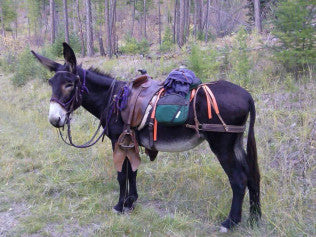Donkeys are fascinating creatures. There are around 50 million in the world today. They can be as tiny as 19 inches and even as large as 17 hands (68 inches). Their coats vary in shades of black, brown, red, grey, white with spots, and pure white.
Unlike the horse world, donkeys are often bought without regard to a particular breed. They are often a mix of several types of breeds that were used to create a desired quality. Those may include strength, agility, or size.
A few of the most rare and unique donkeys are:
American Mammoth Jackstock
The American Mammoth donkey comes from a variety of large European donkeys that were imported to the United States in the late 1700s. They are the largest breed of donkey in the world, the largest being measured at 17 hands.
In order to be recognized as a Mammoth by the Standard Jack and Jennet Registry, jacks (male donkeys) must measure at least 14 hands. The jenny (female donkey) must be at least 13.2 hands. They are easy to recognize with their giant bodies, massive heads, and exceptionally large ears.
In the 1950, Mammoth numbers experienced a drastic drop. This was in part due to tractors being introduced into the farming world. Today they are “Critical” on the conservation priority list.

Pega
The Pega, quite the majestic ass, is a large breed originating in Brazil, and is considered to have pure bloodlines. It has a long, narrow face, uniquely curved ears, and an ambling gate.
Known for being docile and intelligent, it has been bred for over 200 years. Over the past several years, the Pega has gained popularity for creating dressage type mules due to its extraordinary gait. It is now the most popular breed in most Brazilian states.
Though it was on the verge of extinction, the newfound interest for its use in dressage has its numbers back on the rise.
Onager
The Onager is an Asian donkey famously known for being nearly impossible to tame and incredibly fast. It has a unique coat of reddish-brown or yellowish-brown, a black dorsal band fringed in white, and a short, erect black mane.
The Onager has never been domesticated and roams in deserts, plains, grasslands, and savannahs. Once on the endangered list, Onagers were classified in 2015 as Near Threatened by IUCN.

Poitou
The Poitou donkey, also called the Poitevin donkey, is a bit of a shocking sight. Standing between 13 and 15 hands high, this odd creature is covered in shaggy, ungroomed cords. A distinctive coat called a cadanette.
The Poitou originates from the Poitou-Charentes region of France. It is one of the largest donkey breeds in the world. Due to its size, the Poitou was bred with Poitevin horses to create large working mules.
It is an endangered donkey with only a couple thousand left in the world.

Abyssinian
The Abyssinian donkey is a beautiful sight with a slate grey coat (sometimes a chestnut-brown) and zebra stripes up their legs. They can weigh anywhere from 190 pound to 450 pounds. As their leg design may have made obvious, they are related to the zebra.
Abyssinians are native to Ethiopia, and used as beasts of burden. While they are abundant throughout their native land, they are rare in all other parts of the world.
Turkmenian Kulan
The Kulan donkey comes from the Onager wild ass, and is one of the largest subspecies. Even being under Soviet Union protection since 1935, it was declared endanger in 2016 and is on the IUCN Red List. They used to range across Europe, Central Asia, and the Middle East but their number has dwindled by around 95 percent because of hunting and habitat loss.
They are characterized by their pale brown coat, a dark stripe down the spine, and white patches on the sides, back, belly, and nose. Their tales are unusual, and end with a tuft.

Photos From:
https://americanjackstock.org/
https://en.wikipedia.org/wiki/Onager
http://afs.okstate.edu/breeds/other/donkey/poitou/
https://en.wikipedia.org/wiki/Turkmenian_kulan
